Jet with hundreds of passengers aboard plummets 30,000ft in emergency descent
Charter flight from Stansted to Poland's Rzeszow Airport carrying 262 passengers diverted to Amsterdam Schiphol in March last year after alarms activated

Your support helps us to tell the story
From reproductive rights to climate change to Big Tech, The Independent is on the ground when the story is developing. Whether it's investigating the financials of Elon Musk's pro-Trump PAC or producing our latest documentary, 'The A Word', which shines a light on the American women fighting for reproductive rights, we know how important it is to parse out the facts from the messaging.
At such a critical moment in US history, we need reporters on the ground. Your donation allows us to keep sending journalists to speak to both sides of the story.
The Independent is trusted by Americans across the entire political spectrum. And unlike many other quality news outlets, we choose not to lock Americans out of our reporting and analysis with paywalls. We believe quality journalism should be available to everyone, paid for by those who can afford it.
Your support makes all the difference.A passenger jet en route from London to Poland with more than 260 passengers aboard was forced to make an “emergency descent” from 37,000 feet after the cabin failed to pressurise properly, a report has found.
The Titan Air Boeing 767 charter flight from Stansted to Rzeszow Airport, in south east Poland, had just started cruising at high altitude when alarms started going off, an Air Accidents Investigation Branch (AAIB) report found.
The passenger oxygen masks came down and the pilot brought the twin-engine plane down by 30,000 feet and diverted to land at Amsterdam's Schiphol Airport after issuing a mayday call on 19 March last year.
The AAIB investigation found that a faulty positive pressure relief valve (PPRV) meant the aircraft had not pressurised correctly after taking off from the Essex air hub.
Both the aircraft's PPRVs had been replaced with “overhauled” values during “heavy maintenance” before the flight, the report said.
But it added a prior test flight had shown no problems and examination of the part after the incident discovered “no obvious reason for the malfunction”.
Data from the flight recorder showed the seatbelt signs automatically illuminated at 9.40am, some 20 minutes after take-off from Stansted.
The aircraft has 262 passengers and nine crew aboard at the time.
The report concluded: “The failure of the cabin to pressurise correctly resulted from a faulty PPRV which was installed during recent maintenance.
“The maintenance checks of the replacement valves did not identify the defect with the fault PPRV.
“The event was a failure to pressurise correctly, rather than a sudden depressurisation and the crew's timely actions in identifying the problem and carrying out the appropriate emergency procedures ensured a safe outcome.”
PA
Join our commenting forum
Join thought-provoking conversations, follow other Independent readers and see their replies
Comments